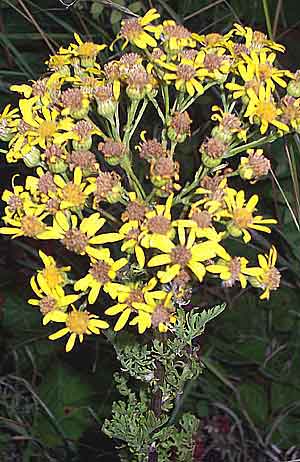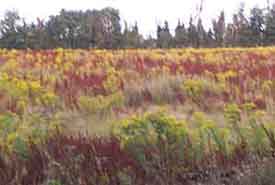The Danger of Ragwort Poisoning for Horses -
A Slow and Painful Death
 Ragwort
poisoning is one of the most common causes of plant poisoning
in equines; with young horses and ponies
most at risk.
Ragwort
poisoning is one of the most common causes of plant poisoning
in equines; with young horses and ponies
most at risk.
It destroys the horse's liver, leading to a slow and
painful death. Most horses affected by ragwort poisoning
die after suffering for periods varying from a week to several months.
Unfortunately once symptoms of ragwort poisoning have appeared in a
horse or pony very little can be done to save
it and, sadly, it will usually die.
A horse or pony can be poisoned by
ragwort without even having any plants in their grazing area. Seeds from
ragwort plants in neighbouring paddocks and fields can be blown
across and contaminate an area apparently free from ragwort. A
horse or pony can inhale or eat these seeds
and become affected by cumulative poisoning.
RAGWORT FLOWERS
Although Ragwort flowers are only seen during the from
May to October, the effects of poisoning can occur at any time of the
year. The plant is most poisonous during its first year of growth when
it appears as a dense rosette of leaves , but with no flowers.
The poisonous effect of ragwort on a horse is cumulative
- a small amount of the plant eaten over a long time is just as dangerous
as a lot being eaten in just a few days.
SYMPTOMS OF RAGWORT POISONING IN HORSES
Symptoms of poisoning do not always appear immediatley after a horse
or pony has eaten a large amount of ragwort. It may take as long as 4
weeks to 6 months for the equine liver disease to develop.
Different horses have different reactions to to the toxins in the plant.
Poorly managed grazing for horses is particularly likely to suffer ragwort
infestations. Closely growing grass restricts the growth of ragwort, whilst
overgrazed paddocks leave patches of soil that leave perfect conditions
for ragwort seeds to germinate.
Horses that eat ragwort as 5% or more
of their total daily diet for more than 20 consecutive days can be expected
to die within 6 months.
It is believed that some equines get to like the bitter
taste of ragwort and may choose to eat it even when there is good grazing
available.
HAY CAN BE A CAUSE OF RAGWORT POISONING
Hay
is a common source of ragwort poisoning. Unfortunately when ragwort
is dried it loses its bitter taste and horses are no
longer able to detect it. So any hay, haylage
or even chaff which contains the weed will be readily eaten.
It is really important to check bales of hay for ragwort
as the toxins are not destroyed whent he plant dies - but it may not always
be easy to recognise ragwort when it is dried and fragmented.
Why you buy hay it may be possible to check the source,
ask what method of weed control was used and maybe even
visit the hayfield that the hay was cut from.
There are 2 acts of goverment in the UK concerning the control of ragwort.
When ragwort appears on agricultural or equestrian
property the landowner is legally required to treat and clear
it. DEFRA may take action where this is not done.
CONTROLLING RAGWORT
- Cutting ragwort down will not kill the
plant - it may even encourage more growth! However, as a
interim measure, cutting may prevent the production and
spreading of seed.
- Chemical spraying with a systemic
weed killer can be effective when used on the the
early rosette stage of ragwort growth; but is not so effective
on older stemmed plants.
- Spring is the best time for spraying fields
for grazing, but don't spray in springtime if you intend
cutting hay from the treated fields.
- Spraying of fields intended for hay production
should be carried out in the
previous autumn.
- Affected fields should all be sprayed
at the same time so as to avoid ragwort seeds spreading
and germinating in
the bare areas left when the dead weeds are removed.
- When ragwort has died down after being sprayed it must
be removed and carefully destroyed before the fields can
be used again for grazing animals.
- Ploughing can be an effective method of controlling
ragwort as long as the grass
reseeding results in a thick, healthy covering of grass.
This can be encouraged by the use of fertiliser.
- Pulling or digging up ragwort plants -
a basic control method that is appropriate when there is
not too much ragwort to deal with. You should wear rubber
gloves to pull up ragwort, as the plants are also poisonous
to humans and the toxins can enter the bloodstream through
the skin.
- Bits of root will be left in the ground after digging
or pulling up - new growth will have to be removed each
year.
- All pulled plant material should be properly
disposed of (see opposite).
- Good grazing management is essential
to the long term prevention of Ragwort infestation. Do not
overgraze or overstock fields. Keep fertilized and do not
allow to become poached or muddy.
|
THE
UK LAW AND RAGWORT
Ragwort is known as an "injurious weed" and its
control is governed by the 1959 Control of Weeds Act
across the whole of the UK.
When the 2003 Ragwort Control Act, which
only applies to England & Wales, came into effect in February
2004 amending the earlier Weeds Act, it gave more protection
to animals, including horses, from the serious effects of
Ragwort poisoning
The combination of the 2 laws makes it easier for government
authorities to serve notices to landowners and/or occupiers
to treat and clear land infested with ragwort. They may prosecute
those that do not comply with these notices.
A Code of Practice is available which gives
advice and guidance on all matters on dealing with Ragwort.
|
ABOUT
THE PLANT RAGWORT (Senecio Jacobaea)
- Ragwort has bright yellow flowers appearing from May to
October.
- It is naturally a biennial plant - its takes two years
to mature to flowering.
- Ragwort can act as a perennial plant
if it is cut or mown.
- In its first year of growth ragwort
has a dense rosette of leaves growing close to the earth
- In their second year ragwort grows to
between 30 and 100cm high.
- Mature plants have dark green leaves with ragged, irregular
edges and woody stems
- It is most poisonous in its first year
- Each ragwort plant can produce about 150,000 seeds
- The seeds have a 70% germination rate.
- Seeds can remain dormant for up to 20 years.
- Seeds are spread widely by the wind.
|
|
 |
SYMPTOMS
& DIAGNOSIS OF RAGWORT POISONING
- The clinical signs of equine ragwort poisoning
usually only become apparent when liver failure
has already occurred.
- Unusual behaviour,restlessness and uncoordinated movement
due to the harmful effects of the toxins on the horse's
brain.
- Depression
- Loss of condition
- Weight loss
- Dull coat
- Poor appetite
- Constipation
- Photosensitisation - with inflammation of the unpigmented
areas of the skin (not the same as sunburn).
- Jaundice
- Diarrhoea
- Seizures
- Blindness
- Coma
Diagnosis can be helped by analysing blood samples or performing
a liver biopsy to look for any signs of liver damage
in the horse |
 |
Treating
Ragwort Poisoning
The first and most obvious thing to do is to remove all traces
of ragwort from the horse's diet and environment.
However once signs of ragwort poisoning become evident it
is often too late for any successful treatment,
although some horses do survive.
There is no effective treatment for Liver failure ( as a
result of ragwort poisoning) - the liver can only be helped
to repair itself.
Feed the horse a healthy diet with easily digestible proteins
and a high carbohydrate level which does not place to much
demand on the liver.
Consult your veterinary surgeon who will discuss the latest
available treatments. |
 |
Diposal of Ragwort Plants
- Defra will provide guidance on the disposal of ragwort
- contact them for more detailed information.
- Ragwort plants should only be moved in sealed bags or
containers as seeds may fall and be dispersed in transit.
- Freshly uprooted ragwort will not burn well due to its
moisture content. and
- Attempting to burn fresh ragwort will result in dark smoke.
- If you are going to burn ragwort let it dry out first
in a covered pile or in paper sacks.
- Do not carry out disposal near ditches, watercourses.
- Ragwort can only be composted using a fully contained
composting system where the draining liquid is contained,
and where the process isn't affected by the weather. The
process must meet The British Standards PAS 100;2005 specification
for composted materials available from WRAP.
- For horse owners rotting down ragwort is likely to be
a more practical solution than composting - use a standard
compost bin with a lid to and add small quantities of ragwort
mixed with grass cuttings some water may be needed to keep
the mixture moist. A period of 12 months should be left
before the compost bin is emptied.
- Ragwort is poisonous to humans. It can enter the bloodstream
through the skin: Wear protective clothing when handling.
|
 |
 |
|
Ragwort poisoning - one of the most common causes of plant
poisoning in equines,
destroying the liver. Young horses and ponies most at risk. For prevention
grazing
should be treated with weedkiller to destroy ragwort

 Ragwort
poisoning is one of the most common causes of plant poisoning
in equines; with young horses and ponies
most at risk.
Ragwort
poisoning is one of the most common causes of plant poisoning
in equines; with young horses and ponies
most at risk.
